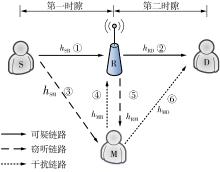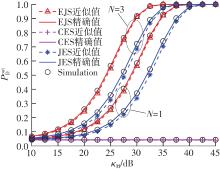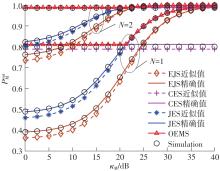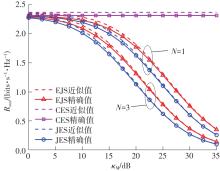| 1 |
ZOU Y, ZHU J, WANG X,et al .A survey on wireless security:Technical challenges,recent advances,and future trends[J].Proceedings of the IEEE,2016,104(9):1727-1765.
|
| 2 |
XU J, DUAN L, ZHANG R .Surveillance and intervention of infrastructure-free mobile communications:A new wireless security paradigm[J].IEEE Wireless Communications,2017,24(4):152-159.
|
| 3 |
ZENG Y, ZHANG R .Wireless information surveillance via proactive eavesdropping with spoofing relay[J].IEEE Journal of Selected Topics in Signal Processing,2016,10(8):1449-1461.
|
| 4 |
WYNER A D,The wire-tap channel[J].The Bell System Technical Journal,1975,54(8):1355-1387.
|
| 5 |
HU G, CAI Y .Proactive eavesdropping with masked power beacon for energy-constrained suspicious communication[J].IEEE Access,2019,7:139035-139046.
|
| 6 |
XU J, DUAN L, ZHANG R .Proactive eavesdropping via jamming for rate maximization over Rayleigh fading channels[J].IEEE Wireless Communications Letters,2016,5(1):80-83.
|
| 7 |
XU J, DUAN L, ZHANG R .Proactive eavesdropping via cognitive jamming in fading channels[J].IEEE Transactions on Wireless Communications,2017,16(5):2790-2806.
|
| 8 |
HAN Y, DUAN L, ZHANG R .Jamming-assisted eavesdropping over parallel fading channels[J].IEEE Transactions on Information Forensics and Security,2019,14(9):2486-2499.
|
| 9 |
ZHANG Y, JIANG X, ZHONG C,et al .Performance of proactive eavesdropping in dual-hop relaying systems[C]∥ Proceedings of IEEE Globecom Workshops.Singapore:IEEE,2017:1-6.
|
| 10 |
MA G, XU J, DUAN L,et al .Wireless surveillance of two-hop communications[C]∥ Proceedings of IEEE 18th International Workshop on Signal Processing Advances in Wireless Communications (SPAWC).Sapporo:IEEE,2017:1-5.
|
| 11 |
HU G, CAI Y, OUYANG J .Proactive eavesdropping via jamming for multichannel decode-and-forward relay system[J].IEEE Communications Letters,2020,24(3):491-495.
|
| 12 |
HU G, OUYANG J, CAI Y,et al .Proactive eavesdropping in two-way amplify-and-forward relay networks[J].IEEE Systems Journal,2021,15(3):1-12.
|
| 13 |
HU D, ZHANG Q, YANG P,et al .Proactive monitoring via jamming in amplify-and-forward relay networks[J].IEEE Signal Processing Letters,2017,24(11):1714-1718.
|
| 14 |
YU B, YANG L, CHENG X,et al .Power and location optimization for full-duplex decode-and-forward relaying[J].IEEE Transactions on Communications,2015,63(12):4743-4753.
|
| 15 |
BANKEY V, UPADHYAY P K .Physical layer security of hybrid satellite terrestrial relay networks with multiple colluding eavesdroppers over non-identically distributed Nakagami-m fading channels[J].The Institution of Engineering and Technology Communications,2019,13(14):2115-2123.
|
| 16 |
YAN S, WANG X, LI Z,et al .Cooperative jamming for physical layer security in hybrid satellite terrestrial relay networks[J].China Communications,2019,16(12):154-164.
|
| 17 |
AN K, LIN M, LIANG T,et al .Secure transmission in multi-antenna hybrid satellite-terrestrial relay networks in the presence of eavesdropper[C]∥ Proceedings of 2015 International Conference on Wireless Communications & Signal Processing (WCSP).Nanjing:IEEE,2015:1-5.
|
| 18 |
GHORAISHI M, JIANG W, XIAO P .Subband approach for wideband self-interference cancellation in full-duplex transceiver[C]∥ Proceedings of 2015 International Wireless Communications and Mobile Computing Conference (IWCMC).Dubrovnik:IEEE,2015:1139-1143.
|
| 19 |
LIANG D, XIAO P, CHEN G .Digital self-interference cancellation for full-duplex MIMO systems[C]∥ Proceedings of 2015 International Wireless Communications and Mobile Computing Conference (IWCMC).Dubrovnik:IEEE,2015:403-407.
|
| 20 |
KOLODZIEJ K E, PERRY B T, HERD J S .In-band full-duplex technology:Techniques and systems survey[J].IEEE Transactions on Microwave Theory and Techniques,2019,67(7):3025-3041.
|
| 21 |
ABRAMOWITZ M, STEGUN I A .Handbook of mathematical functions with formulas,graphs,and mathematical tables[M].9th ed.New York,:Dover,1972.
|
| 22 |
SENARATNE D, TELLAMBURA C .Unified exact performance analysis of two-hop amplify-and-forward relaying in Nakagami fading[J].IEEE Transactions on Vehicular Technology,2010,59(3):1529-1534.
|
| 23 |
HUANG Q, LIN M, ZHU W,et al .Performance analysis of integrated satellite-terrestrial multiantenna relay networks with multiuser scheduling[J].IEEE Transactions on Aerospace and Electronic Systems,2020,56(4):2718-2731.
|
| 24 |
GRADSHTEYN I S, RYZHIK I M .Table of integrals,series,and products[M].7th ed.San Diego,CA:Academic,2007.
|
| 25 |
CORLESS R M, GONNET G H, HARE D E G,et al .On the Lambert W function[J].Advances in Computational Mathematics,1996(5):329-359.
|









